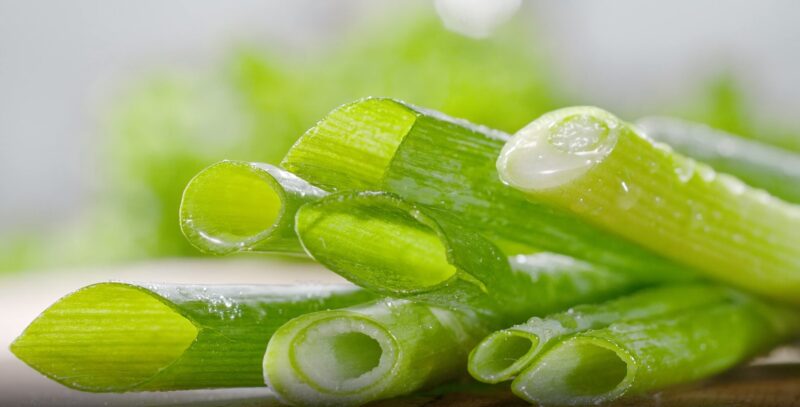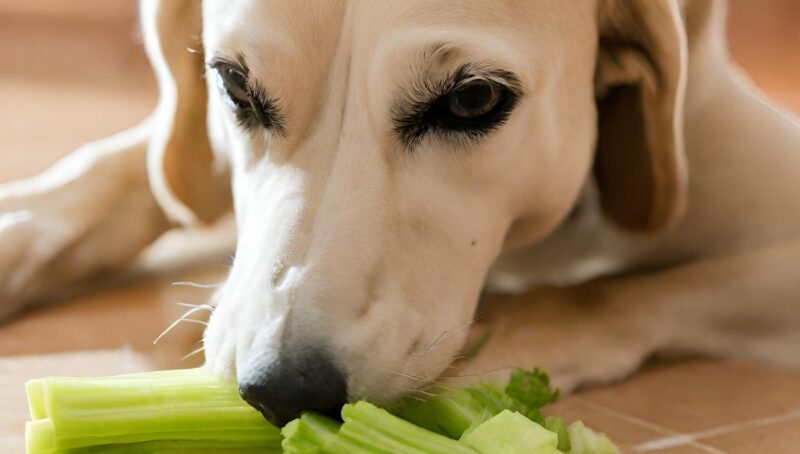When it comes to feeding our furry friends, it’s crucial to know which foods are beneficial and which could be harmful. Vegetables often come up in discussions about healthy diets for pets, particularly the role they play in a balanced canine diet. This article explores one specific vegetable: celery. We’ll examine its nutritional benefits, potential risks, and how to safely incorporate it into your dog’s diet.
Is Celery a Good Dietary Option?
When considering specific vegetables for your pet’s diet, it’s crucial to assess both safety and nutritional value.
- Safe for Canine Consumption: Celery is non-toxic to canines, making it a safe addition to their diet in moderation. It’s important to introduce any new food gradually to monitor for any adverse reactions, such as allergies or digestive upset. The fibrous nature of this vegetable requires it to be cut into small, manageable pieces to prevent choking hazards and aid in digestion.
- Health Benefits: This vegetable offers several health benefits when included in a canine diet. It’s low in fat and cholesterol, making it an excellent snack for pets, especially those needing weight management. Rich in vitamins A, C, and K, it contributes to maintaining healthy skin, boosting immune function, and supporting bone health. Additionally, its high water content can help keep your pet hydrated, particularly beneficial during warmer months.
- Considerations for Optimal Benefits: To maximize the benefits while minimizing risks, it’s essential to follow certain guidelines. Firstly, always wash it thoroughly to remove any pesticides or contaminants. Secondly, it should be given in small quantities, as excessive consumption can lead to gastrointestinal upset due to its high fiber content. Lastly, it’s best served raw or steamed, as cooking can deplete some of its nutritional value.
How to Include it in the Dog’s Diet?

Introducing new foods into your pet’s diet should be done thoughtfully. There are cases where it could be difficult, depending on the typical food your little friend got used to.
- Starting Small: Begin by offering small amounts of celery to your pet. This gradual introduction allows you to observe how your pet reacts to this new food. Some dogs might experience mild digestive discomfort initially, which is why starting with small portions is crucial. If your pet shows any signs of adverse reactions, such as diarrhea or vomiting, it’s best to discontinue and consult your veterinarian.
- Preparation Techniques: The way you prepare celery can impact its safety and appeal to your pet. Chopping it into small, bite-sized pieces can prevent choking and make it easier for your pet to digest. You can serve it raw, which preserves most of its nutritional value, or steam it to soften the fibers, making it gentler on your pet’s digestive system. Avoid adding any seasonings or oils, as these can be harmful to pets.
- Frequency and Quantity: Moderation is key when adding celery to your pet’s diet. It should not replace their regular meals but rather complement them. Treat it as a snack or a small part of their meal. A good rule of thumb is to ensure that treats, including vegetables like celery or cucumbers do not make up more than 10% of your pet’s daily caloric intake.
Nutritional Benefits of Vegetables in a Dog’s Diet

Vegetables are an important part of a balanced diet for pets, offering a range of vitamins, minerals, and fiber. While many vegetables are safe and healthy for canines, it’s essential to understand their specific benefits and how they fit into a pet’s nutritional needs.
- Vitamins and Minerals: Vegetables are rich in essential vitamins and minerals that support various bodily functions in pets. For example, they often contain Vitamin A, vital for maintaining good vision, skin health, and immune function. Vitamin C, although not a dietary requirement for canines as they synthesize it themselves, can still offer antioxidant benefits when included in small amounts. Minerals like potassium and magnesium found in some vegetables are crucial for nerve function, muscle health, and maintaining fluid balance.
- Fiber Content: The fiber in vegetables is beneficial for digestive health in pets. It aids in regular bowel movements and helps in maintaining a healthy weight. Fiber-rich foods can be particularly beneficial for pets with certain digestive issues, as they help to regulate the digestive system. However, it’s important to introduce high-fiber foods gradually to avoid digestive upset.
- Low-Calorie Treats: For pets struggling with weight, vegetables like cucumbers can be a great low-calorie treat option. They provide a sense of fullness without the excess calories found in many commercial treats. This can be particularly beneficial for pets on a weight management plan, as it allows owners to treat their pets without compromising their dietary needs.
Potential Risks and Considerations

While celery offers various benefits, it’s also important to be aware of potential risks and considerations when feeding it to your pet.
- Choking Hazard: Due to its fibrous nature, celery can pose a choking risk, especially for smaller dogs or those that tend to gulp their food. Always cut it into small, manageable pieces and supervise your pet while they’re eating to minimize this risk.
- Digestive Issues: Some dogs may have sensitive digestive systems, and the introduction of new foods like celery can cause issues such as gas or diarrhea. If you notice any signs of digestive distress, reduce the amount or discontinue feeding it.
- Allergic Reactions: Though rare, some dogs can be allergic to certain foods, including vegetables. Symptoms of an allergic reaction can include itching, swelling, or difficulty breathing. If you observe any of these symptoms, stop feeding celery immediately and consult your veterinarian.
Balance is Crucial

Understanding the balance between vegetables and meat in your pet’s diet is crucial.
- Importance of Meat: Meat is a fundamental component of a canine’s diet. It’s a primary source of protein, which is essential for muscle growth, repair, and overall health. Meat also provides essential amino acids, vitamins, and minerals that are crucial for your pet’s health. Dogs are omnivores with a strong carnivorous bias, meaning while they can eat a variety of foods, meat should form the cornerstone of their diet.
- Role of Vegetables: Vegetables, while not a natural part of a canine’s ancestral diet, can offer additional nutrients and fiber. They can enhance a pet’s diet by providing vitamins and minerals that may not be sufficiently available in meat. Vegetables also offer variety in texture and flavor, which can be beneficial for pets who are picky eaters or those on a restricted diet.
- Finding the Right Balance: The key is to find a balance that suits your pet’s specific nutritional needs. This balance can vary based on age, breed, activity level, and health conditions. Generally, a healthy canine diet should consist predominantly of high-quality meat, with vegetables being a supplementary component. Consulting with a veterinarian or a canine nutritionist can provide tailored advice for your pet’s unique dietary requirements.
Can a Dog Be Vegetarian?
The idea of a vegetarian diet for dogs often sparks debate.
- Feasibility of a Vegetarian Diet: While dogs are naturally inclined towards a meat-based diet, with careful planning and monitoring, a vegetarian diet can be feasible for some dogs. It requires ensuring that all necessary nutrients, particularly protein and essential amino acids, are adequately provided through non-meat sources.
- Challenges and Considerations: The main challenge in a vegetarian diet for dogs is ensuring they receive enough high-quality protein. Plant-based proteins often lack certain amino acids that are vital for dogs. Additionally, some dogs may have difficulty digesting large amounts of plant-based food. It’s also crucial to monitor for nutrient deficiencies, particularly in vitamins and minerals typically found in meat.
- Consulting with Professionals: If considering a vegetarian diet for your pet, it’s essential to consult with a veterinarian or a canine nutritionist. They can help formulate a balanced diet plan and recommend supplements if necessary. Regular health check-ups will also be important to ensure that your pet remains healthy on a meat-free diet.
FAQs
Are there any specific breeds that should avoid celery?
Generally, celery is safe for most breeds. However, dogs prone to urinary oxalate stones should avoid it, as celery contains oxalates, which can contribute to stone formation. Always consult with your vet if your dog has a history of urinary issues.
Is it better to feed my dog raw or cooked celery?
Both raw and cooked celery are safe for dogs. Raw celery provides more crunch and can help with dental health, while cooked celery is softer and easier to digest. Avoid seasoning or adding oil when cooking celery for your dog.
How often can I include celery in my dog’s diet?
Celery should be an occasional treat, not a daily dietary staple. Including it once or twice a week in small quantities is a good guideline. Always consider the overall balance of your dog’s diet.
Can celery cause any vitamin or mineral imbalances in dogs?
While celery is rich in certain vitamins and minerals, feeding it in moderation is unlikely to cause imbalances. However, excessive consumption could contribute to imbalances, particularly in calcium and phosphorus. Balance is key in any dietary changes.
Summary
Incorporating vegetables like celery into your dog’s diet can offer numerous health benefits when done correctly. These additions should be seen as supplements to a well-balanced diet primarily based on high-quality meat.
Celery, in particular, can be a healthy, low-calorie treat that provides hydration, fiber, and essential nutrients. However, it’s important to remember that moderation is key. Introduce any new food gradually and observe your pet’s reaction.
The decision to include vegetables in your pet’s diet should be informed and intentional. Always consider your dog’s specific dietary needs, health conditions, and preferences.

